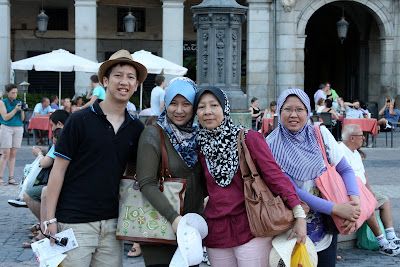 Bulan
Bulan Syawal sudah beberapa hari berlalu. Kini kita sudah melangkah ke bulan Zulkaedah dan dalam beberapa hari lagi, mulalah jemaah-jemaah haji kita berangkat berduyun-duyun menuju ke kota suci Mekah dan kota Madinah al-Munawwarah bagi menyempurnakan ibadah haji - rukun Islam kelima.
Tidak semudah itu untuk terpilih menerima jemputan menjadi Tetamu Allah di rumahNya Baitullahil Haram. Sering dinyatakan menunaikan fardu haji secara holistiknya adalah satu jemputan istimewanya. Terlampau ramai yang ingin pergi tetapi terhalang dengan pelbagai sebab dan kejadian. Sehinggakan ada sebahagian daripada mereka yang sudah mempunyai passport dan gelang haji terpaksa ditangguhkan pemergian. Ada juga kes, secara tiba-tiba tergerak hati, isi borang, buat rayuan dan seterusnya tiba di Tanah Suci menunaikan fardu haji. Benar, ia adalah satu jemputan dari Tuan Rumah, Pencipta yang Maha Agung. Dalam kebanyakan kes, ia kelihatan dirancang, mengikut jadual dan tanpa sebarang 'kecoh-kecoh' yang luar biasa.
Pertimbangkan kisah berikut yang dipetik dari buku 'Travelog Haji' tulisan Professor Muhd Kamil Ibrahim mengenai rakan beliau, Dato XYZ yang menceritakan:
"Dulu saya tidak memahami atau tidak ambil kisah apabila orang menyatakan yang menunaikan fardu haji hanya boleh berlaku atas jemputan Allah. Saya fikir ia semudah cari duit, daftar Tabung Haji dan pergi."
"Pengajaran yang saya peroleh cukup hebat. Tahun 2004, saya menerima kad jemputan dari King of Saudi untuk mengikuti rombongan Seri Paduka Baginda Yang DiPertuan Agong menunaikan fardu haji. Tidak perlu VISA. Segala-galanya kelihatan istimewa. Saya kabarkan kepada hampir semua orang dengan bangganya bahawa yang saya akan pergi atas jemputan Raja."
"Kumpulan kami adalah seramai 12 orang, terdiri daripada mereka berkedudukan tinggi dalam dunia korporat, berkuasa dan hampir boleh melakukan 'apa saja'. Kami pergi secara berasingan daripada rombongan utama dan tiba sehari dua sebelum waktu wuquf."
"Ringkaskan cerita, hari wuquf telah diawalkan sehari dan apabila kami tiba terdapat pelbagai masalah di lapangan terbang (masalah yang tidak sepatutnya berlaku). Kami terpaksa bermalam di Golden Lounge dan terlepas hari Wuquf. Pelbagai usaha telah dilakukan untuk membenarkan kami memasuki Makkah. Tetapi hampa."
"Pada ketika ini, barulah kami sedar betapa kerdilnya kami di sisi Allah. Undangan dari King of Saudi tidak dapat menyelamatkan keadaan. Kehebatan kami di dunia tidak bererti langsung. Masing-masing terasa hina dan malu untuk pulang ke Malaysia. Lalu kami menyimpang ke Mesir dan berehat selama 7 hari di sana, 'melakukan tawaf di piramid."
Syukur Alhamdulillah, bagi mereka yang reda dan beruntung terpilih untuk menjadi Tetamu Allah di musim haji tahun ini, kita panjatkan doa ke hadrat Allah swt agar mereka kesemuanya mendapat petunjuk dan hidayah serta perlindungan daripada Allah swt yang maha Pengampun lagi Penyayang dan semoga segala urusan dan perjalanan ibadah haji mereka dipermudahkan dan berjalan dengan lancar dan semoga mendapat haji yang mabrur.
Di kesempatan ini jua, seluruh warga kerabat Haji Awang Omar/Hajah Siti Aminah ingin mengucapkan selamat menunaikan fardu haji kepada anakda/cucunda Awang Noor Hadi bin Haji Noor Kaseh dan isteri beliau, Dayang Hajah Zaleha binti Haji Yahya dan semoga mereka sentiasa berada dalam keadaan sihat walafiat dan selamat kembali ke tanah air dengan mendapat haji yang mabrur. Amin, ya Rabb...........
Allah berfirman dalam surah al Hajj, ayat 27, yang mafhumnya, "Dan serukanlah umat manusia untuk mengerjakan ibadat Haji, nescaya mereka akan datang ke rumah (Tuhan) mu dengan berjalan kaki, dan dengan menunggang berjenis-jenis unta yang kurus, yang datangnya dari berbagai jalan (dan ceruk rantau) yang jauh."
Salam hormat - PUDA















































